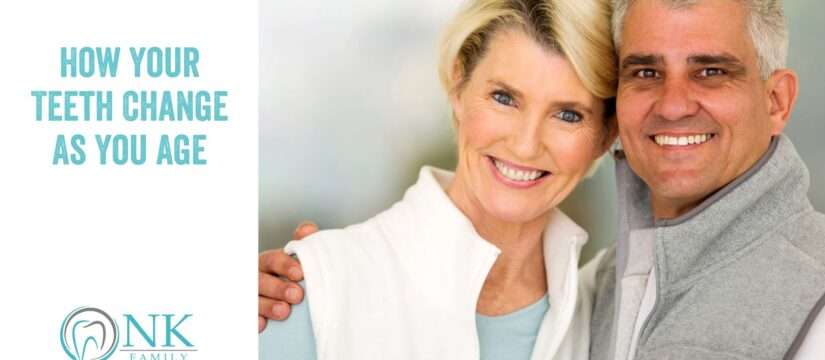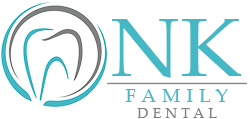
Do your teeth seem to be moving around your mouth? Are your pearly whites no longer so bright? Are your teeth actually growing? If you’ve celebrated more than a few birthdays, these changes may be puzzling, but are a normal part of getting older! Learning how your teeth change as you age can help you anticipate what to expect, as well as how to be increasingly vigilant in heading off conditions that may result in tooth loss.
Why Teeth Shift as You Age
Teeth can shift — otherwise, orthodontic treatment wouldn’t be possible! But they can also shift all on their own. As Colgate explains:
“While it can be tempting to think of your teeth as totally immovable, they offer some flexibility and movement over time, thanks to how they’re fixed to your mouth. Your teeth are connected to your upper and lower jawbones by the periodontal ligament and cementum material. This unique combination allows your mouth to withstand the forces placed on your teeth by chewing and other regular activities.
“Your teeth shift naturally throughout your life and as the result of other stressors and triggers. Orthodontic treatment often uses this natural capacity for change by deliberately altering your teeth and bite position.”
Speaking of orthodontic treatment, don’t be surprised that if you spent a few of your teen years as a metal mouth, your hard-earned perfectly aligned teeth — especially the lower ones — are drifting apart from each other. New York Times writer Jancee Dunn noted this ironic indignity in her essay, “Four Weird Signs You’re Getting Older.”
“My lower teeth have grown a lot more crooked over the last few years. This is a surprise. They were once perfectly straight, thanks to braces that stayed on throughout three ungainly middle school years. I asked a few friends in midlife whether they had noticed the same thing, and some reported that they, too, had newly crooked lower teeth.”
However, the following factors can set teeth in motion in middle age, regardless of earlier orthodontic treatment:
Bone density loss — As we age, the bone density in our jaws can decrease, leading to a weaker foundation for teeth.
Jawbone changes — The jawbone can shrink and change shape, which can alter the support structure for teeth, causing them to shift.
Gum recession — Gum recession, where the gums pull away from the teeth, exposes more of the tooth root, which can lead to teeth shifting.
Ligament relaxation —The ligaments that hold teeth in place can relax, allowing teeth to move more easily.
Tooth wear — Everyday chewing and grinding can wear down teeth, potentially changing their shape and causing them to shift.
Teeth grinding (bruxism) — Excessive or habitual grinding of teeth can put pressure on teeth, leading to shifting.
Tooth loss — Losing a tooth can cause adjacent teeth to shift into the empty space, disrupting the alignment of the entire dental arch.
Periodontal (gum) disease — Gum disease can damage the gums and bone supporting the teeth, leading to tooth movement and misalignment.
Is there a way to prevent your teeth from shifting, or realign them if they’ve already started? Hodge Orthodontics offers the following advice:
“Of course, the best safeguard against receding gum lines that cause teeth to weaken and shift is a good oral hygiene routine. Regularly brush your teeth, but don’t stop there! One of the best things you can do for gum health is to regularly floss. Receding gum lines are a huge risk to your oral health, causing plaque buildup between teeth that causes decay, cavities, and bone loss. Don’t let a bad oral hygiene routine become a ticking time bomb for your straight, healthy smile.
“You can also talk to your dentist or orthodontist about restorative dentistry like veneers or crowns that can help prevent teeth from shifting. If you’ve had braces or other orthodontic work done before, wear retainers or other aligners as recommended by your orthodontist to keep your teeth in place. You can also ask your dentist or orthodontist about getting fitted for a mouthguard to wear at night to prevent yourself from subconsciously — and unconsciously — damaging your teeth by grinding or clenching them in your sleep.”
Why Teeth Yellow as You Age
As we get older, the porous outer layer of enamel on our teeth begins to thin. Factors are typically a combination of accumulated wear-and-tear from daily activities — including eating, consuming acidic foods and drinks, and even brushing. This allows the naturally yellow material beneath it — called dentin — to show through more prominently. The thinner your enamel, the more dentin shows through, giving teeth a yellow tint. Since enamel is also naturally porous, as we age, the microscopic holes within it get larger. This leaves teeth even more susceptible to staining. Our blog post — “Tooth Anatomy 101” — describes the relationship between enamel and dentin in detail.
Even if you treat your teeth gently and have them professionally cleaned on a regular basis during your twice-yearly dental examinations, they’re still likely to lose some amount of enamel over time. For this reason, it’s imperative to consult with your dentist about the cause of your tooth discoloration and not take it upon yourself to buy an over-the-counter whitening product. You could do far more harm by damaging your remaining enamel!
Unfortunately, this means you are not likely to be a candidate for a professional teeth whitening procedure. However, your dentist can offer options that provide the desired aesthetic effect — such as composite bonding, veneers or crowns — which will give you the white, bright smile you want while also protecting your teeth. Our blog post — “How Your Smile Can Make You Look Younger” — covers this topic in detail.
Why Your Gums Recede as You Age
If it seems your teeth are getting longer, they aren’t. Gum recession is a common condition among older adults. In fact, the expression “long in the tooth” refers to the tendency of gum tissue to pull away from teeth over the years — thereby creating the appearance of longer teeth — as an indicator of progressed age. Formally known as gingival recession, the process can start at any age, but is more typical for those ages 50 and older.
The part of the tooth visible above the gum line (the crown) is only about half of its overall structure. Each tooth has a root structure that goes into the jawbone, where it’s anchored. The gums form a tight seal around the teeth — which not only helps keep them in place, but to prevent bacteria from getting into their roots.
When gum recession occurs, “pockets,” or gaps, form between the teeth and gum line, making it easy for disease-causing bacteria to build up. As Willow Glen Dental Specialists explains, “If your gums begin to recede, more of your tooth and its roots are exposed to potentially harmful bacteria. Making matters worse, recession often causes a loosening of the overall seal, which means bacteria and debris can more easily make their way inside your gums and down to the roots.”
Gum recession can be mild, severe, or moderate and may affect multiple teeth or one tooth. Early symptoms often go unnoticed because the process is so gradual. The most apparent sign of gum recession is tooth root exposure, but the process is far advanced by that point. In its advanced stage, the absence of supporting gingival (gum) structure leads to loosening of the teeth, and eventual tooth loss. Of course, if you schedule regular six-month dental check-ups, your dentist will catch gum recession early on — and be able to advise you on treatment and care options.
Despite its association with age, gum recession has no single cause. Each of the following — or a combination thereof — can be a factor:
- Brushing too hard or too aggressively.
- Dental plaque or tartar buildup.
- Periodontal disease.
- Trauma or injury to your gum tissue.
- Abnormal tooth positioning (misalignment).
- Smoking or chewing tobacco use.
- Lip and tongue piercings.
- Genetic predisposition.
- Living with diabetes.
- Medications that cause dry mouth.
- Certain diseases, such as HIV.
- Hormonal changes in females.
As our blog post — “What You Need to Know About Gum Recession” — covers, most mild gum recession cases do not need treatment. Your dentist may advise you on better oral health care and preventive measures. Basic steps to take include practicing proper tooth brushing techniques to prevent damaging gums. Use a soft-bristled toothbrush and avoid over-brushing, applying gentle strokes. If applicable, stop the use of tobacco products and reduce alcohol consumption.
If you have a mild or moderate case of gum recession, your dentist may suggest the following treatment options:
Desensitizing agents, varnishes, and dentin bonding agents — These products aim to reduce the sensitivity of the exposed tooth root. Desensitizing agents treat the nerve symptoms and help preserve oral hygiene by easing the brushing of sensitive teeth.
Composite restoration — A dentist uses tooth-colored composite resins to cover the surface of the root. They can also close the gaps between teeth.
Pink porcelain or composite — This material is the same pink color as the gums. Dentists can use it to fill the gaps where the gums have receded.
Removable gum veneers — These are usually acrylic or silicone, and they artificially replace the large area of missing gum tissue due to recession.
Orthodontics — These include treatments that slowly move the position of the teeth over a long period. This repositioning can correct the gum margin and make it easier to keep the teeth clean.
Surgery — A dental surgeon will graft tissue from another site in the mouth. This tissue heals over the gum recession. A person would usually only need this to treat severely receding gums.
The Take-Home Message
The aging process affects the entire body, and the teeth, gums, etc., are no exception. Paying attention to changes and staying dedicated to maintaining excellent oral care can pay off in a healthy, attractive smile you’ll be proud of throughout life!
At NK Family Dental, it is our mission to provide the highest quality and most compassionate oral care to our Chicago patients, including both dental and periodontal services. Our practice is trusted for advanced oral surgery procedures and comfortable root canal treatment.
Our team of experienced, dedicated dental professionals will help address your oral health concerns, and determine the best solution for you based on your individual situation. We strive to identify treatment options that fit your needs.
Our dental specialists include our general dentist, Dr. Nilofer Khan, our endodontist, Dr. Sabek, and our periodontist, Dr. Amir Danesh. Dr. Danesh is a board-certified periodontist and Diplomat of the American Board of Periodontology. He has contributed to the publication of two books, as well as published over 20 papers in prestigious dental research journals.
We serve the neighborhoods of Logan Square, Bucktown, Humboldt Park, and Wicker Park with the dedication that’s earned us the reputation as the Best Dentist in Chicago!
We understand that the main concern you may have is cost, which is why we accept all major PPO plans for dental insurance and also offer our in-house dental plan. Please see our financing page for more information.
Schedule your visit through ZocDoc, or contact us directly. We look forward to treating you soon!
